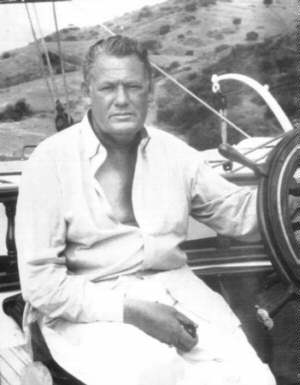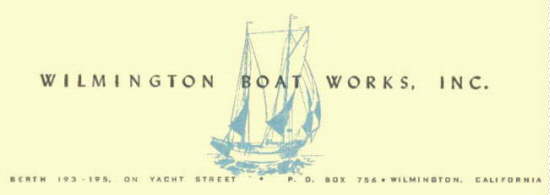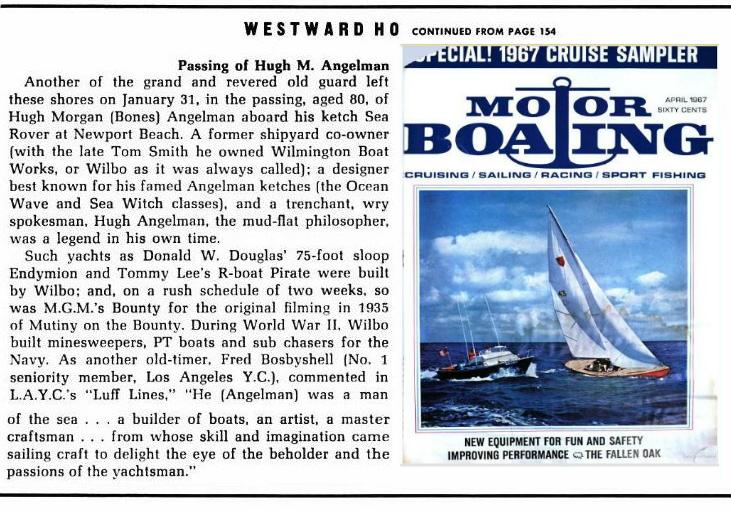|
|
The man who became the
celebrated "grand old man of Pacific yachting,"
started life high and dry on the Texas plains, hundreds of miles from
the nearest salt water. Born on March 7, 1886, in the farming community
of Bonham, north-northeast of Dallas near the Oklahoma border, Hugh came
into the world as Hugh Morgan.
An
unsubstantiated rumor has it that he was a descendant of Sir Henry
Morgan, the 17th century buccaneer. While this may be doubtful, he does
seem to have been born with sea and sail in his genes, and would
eventually loom as large as Texas in the yachting and boat building
communities in the environs of Los Angeles, California.
Though nothing seems to be known of Hugh's father,
his mother was Cora Mae Morgan. Apparently growing tired of the Texas
farmlands, she decided to seek a new life on the west coast. With six
year old Hugh in tow, she pulled up stakes and moved to Los Angeles. It
wasn't long after their arrival that Cora met and married Eugene
Angelman, and mother and son acquired a new last name.
As with many who become legends in their own time,
some myths developed around Hugh's image. One conveyed a mythical origin
to his last name. Probably as the result of jest, the story has
circulated that
Hugh, an "orphan" from Texas, took the name Angelman from the
City of Angels that became his adopted home.
It wasn't long after his arrival in that city, that the sea and boats
began casting their spell over Hugh.
Apparently he had an ambition to build boats very early in life. Being a
sufficiently studious lad, at the age of eight he discovered the local
library. The very first book he borrowed was entitled Elements of Boat Building.
The story,
which he
must have later told on himself, has it that (not yet knowing the proper way to check a book out), he simply
tucked it under his arm and exited with it through an open window.
True to what seemed his destiny, Hugh found his first jobs in the
boatyards around the Los Angeles harbor area, and served an
apprenticeship at the Marine Equipment Company.
Of course, he became an
avid and accomplished sailor early, crewing on racing yachts (and
probably any other kind of yacht), at
every opportunity. Racing sail remained one of Hugh's
passions throughout his life, and many of the boats he later designed
and built were designed with the hope they would be successful racers,
and many of them were.
Once, in the early 1920s, when seeking a race for one of his
creations, Angelman is reputed to
have said, "We'll race 'em for money, marbles, or chalk".
Along with his racing, coastal cruising, and building
of yachts, Hugh became a prime mover in Los Angeles' growing yachting
community. In addition to being one of the founders of the Los Angeles
Yacht Club, he became a member of the Catalina Island and Portuguese Bend Yacht
Clubs.
Hugh met Leslie Griffin, his bride to be, when
he was 19 years of age in 1905 and she only 15. Leslie shared Hugh's love of sailing and they explored the coast of southern California
together in whatever sail boats Hugh could find to sail in.
Connie Luffkin, in an article on the
"Residential
History of Portuguese Bend, Rancho Palos Verdes, Los Angeles" mentions Hugh briefly:
"In 1905, a yachtsman, Hugh
Angleman, sailed into Portuguese Bend with his bride, to show her an area he felt was unmatched for its wild beauty and was otherwise inaccessible except by a 7-mile trail from Point Fermin. She never forgot the experience, and returned years later to make it her
home." (http://www.geocities.com/pbchost/History/history.htm).
The marriage took place in 1907, and eventually produced three children, one of whom, a boy, died in
infancy. The other two were daughters, Ida and Mae.
Due to Ida's frail
health, Hugh moved his family inland where he went to work in a glass
factory, and it was in the field of stained glass that Hugh established
his first business making and installing windows in churches. But
glass was not Hugh Angelman's forte, and the business soon went
bankrupt.
After that business failure, the Angelmans
returned to the coast and Hugh resumed work and study at various
boat yards, rising to the position of foreman by the end of the
First World War.
In 1919, Hugh and a friend, Willard Buchanan,
teamed up and built a boat on the Los Angeles waterfront. This
successful project attracted the attention of a wealthy man named Tom
Smith. Tom liked what he saw well enough to advance them the money to build a boat for him. Not only did
Hugh and Willard build the boat in a surprisingly short
time, they built two of them! Smith took one, the "Little Warrior,"
and the other, "Deep Water" became the Angelman family boat.
Smith was so impressed with Hugh and Willard's
accomplishment that he provided them with the
financial backing to launch Wilmington Boat Works in 1920.
And thus began the career that would produce an impressive array of some
of the finest sail and power boats ever built.
By 1922, "Wilbo" (as the yard became
informally known), had been successful
enough to requiring more room, and it moved
to its final location on the Wilmington waterfront East Basin. Under
Smith's direction, Angelman and his crew built two houses on the
property, one for Smith, and one for Hugh and his family.
While Hugh was becoming a master boat builder, he developed his natural boat designing talents and though he built
an array of boats designed by other famous designers of the day, his own
designs became the most famous of all. Over the years, the list of
Angelman designs grew to an impressive length, of both power and sail
vessels of all types and sizes.
Angelman designed and built a yard office in the form
of a sailing ship's great cabin, and this unique "office," which had a fully
outfitted galley, became a
waterfront institution in itself. Friday evening gatherings at the Wilbo
office for business, camaraderie, and a good meal became a tradition. Tom Smith
himself served as chef, and the "ship room" hosted an array of
guests that included the worthy yachting and boat yard fraternity, along
with occasional Hollywood celebrities.
The Hollywood connection contributed to Wilbo
landing the job of building the 36 foot replica of the HMS Bounty, for
the 1935 movie, Mutiny on the Bounty, staring Charles Laughton and Clark
Gable.
The Wilbo crew worked feverishly around the clock to complete the
project in only three weeks, and were later appalled to watch it burn to
the waterline in
the movie.
Hollywood celebrities became some of
Wilbo's most notable customers, and Spencer Tracy, Dick Powell, John Wayne, Ernest K. Gann were among
the movie luminaries to have boats built by Hugh at Wilbo.
Hugh Angleman's reputation and professional
success, of course, owed a lot to his business partners, several design assistants,
and skilled and dedicated workers. He was skilled at choosing the right
people for the job, and many unsung helping hands quietly contributed to
both the success of the yard and the Angelman phenomena.
Most
outstanding among them were Willard Buchanan, Vic Ward, Nick Potter,
Harry and Bob Carlson, Dave Lee, Merle Davis, and Charles Davies
designers, loftsmen, patternmakers, and shipwrights to name only the
most prominent. Perhaps the most recognized of all was Angelman's protιgι,
and most prominent long-time design partner, Charles Davies.
Though a success from the beginning, Wilbo experienced
its share of business ups and downs during its long history. It
prospered, fell on hard times, and prospered again, producing fine sail
and power yachts of every step of the way. Lacking orders, there was
usually at least one boat being built on speculation to provide work for
the men. They never
failed to sell, and sometimes got the yard out of a financial bind.
During
Prohibition, fast motorboats were in demand. Law enforcement required
fast boats to overtake the bootleggers, and the bootleggers needed fast
boats to outrun the revenuers. And Wilbo was pleased to satisfy the
demands of both markets.
In 1937 Hugh designed what many consider the crown jewel of
his career the 35 foot,
gaff rigged auxiliary ketch, Sea Witch. He designed and built it for
himself with an eye toward safety, comfort, and the romantic tradition
of the great clipper era almost undoubtedly naming it for the famous China tea
clipper of that name. She was completed in 1939, but it caught the eye
of an eager buyer and Hugh let the Sea Witch slip from his grasp.
Realizing his loss, Hugh built another
exactly like it the Sea Rover which was completed in 1941, just
before the Navy came knocking at the beginning of World War II. The Sea
Rover remained the Angelman boat for over two decades, until Hugh was
forced by old age to retire from active boating.
|
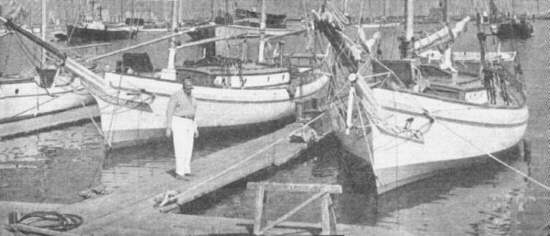
Left to right: Sea Rover, Hugh
Angelman, and Sea Witch (circa 1941)2
|
During the Second World War, Wilbo was
requisitioned by the Navy Department for the duration, a
circumstance that Hugh hardly relished. Hugh helped design, and the yard
built, FT boats, minesweepers, and sub chasers throughout the war years.
Hugh had gained the reputation of being one of the
finest designers and builders of the times, and in spite of his dislike
for Navy work (or perhaps, because of it), he was "chosen by his fellow West Coast shipbuilders as their arbitration representative to the United States Government."
Though he was
quite willing to do his patriotic duty, being under the managerial
control of naval brass and government bureaucrats seems to have entailed
more headaches and frustrations than rewards. At one point he sent a
letter to a friend expressing some of his frustrations. A single
paragraph just about sums it up:
We are building the ship with a deck load of Gold Braid, a bottom planked with creditors and a cargo of confusion. However, we walk the quarterdeck with a determined stride and steer a straight course, although the compass goes around with the sun. It seems a long and devious route must be sailed before we fetch up in Catalina Harbor, so we are carrying
on.
Untiringly yours,
Hugh
The Mudflat Philosopher
In 1945 Hugh turned management of Wilmington
Boat Works over to his former son-in-law Bob Carlson (who had married,
and later divorced, his daughter Mae). Though divorced from Mae, Hugh continued to look upon
Bob as a son. At
about the same time he sold his interest in the business to William L.
Horton, and finally retired from active boat building, though he remained
closely associated with
the yard, more or less in the capacity of a consultant. He often visited
Wilbo to inspect the progress of Angelman designs the yard continued to build.
|
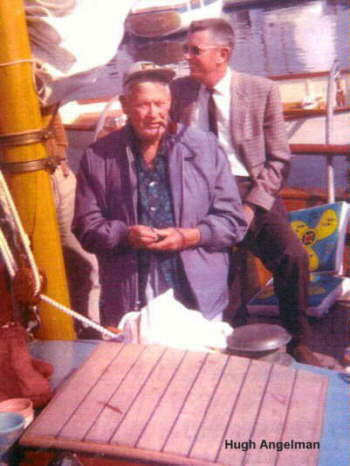
Hugh with unidentified friend on
Sea Rover3
|
In 1949, along with some other long-time
associates, Angelman was persuaded
to go to work
for the South Coast Company in Newport Beach. Among other things, Hugh
was a prime mover in the construction of a replica of another old-time
sailing ship there and it was at South Coast, in April of 1950, that "Moonbeam"
was launched. Moonbeam was considered an updated Sea Witch but
without most of those bewitching charms. Later, in the 50's, Hugh
joined Charles Davies in his boat surveying business, and the two of
them sold plans for some of their most popular designs.
The years 1949 and 1951 brought considerable
acclaim to Angelman's Sea Witch design. The beamy, gaff-rigged, Sea
Witch surprised a lot of people by
placing admirably well in the Transpac race
from California to Honolulu in those years. In fact, it won the 1951 race on
corrected time, and the design received considerable attention in the
print media as a result and the design enjoys an enduring popularity, though it has been many years since the last Sea Witch was
launched.
After the war, Hugh had finally designed and built
Leslie's dream home in Portuguese Bend the place they had first admired
some four decades earlier, when Hugh had sailed into the cove with Leslie. As an integral part of the
house, he built another "ship room" in the tradition of the
Wilbo yard office.
Unfortunately, within a few years, the Portuguese Bend home fell
victim to the Pacific Coast's propensity toward earth quakes and land-slides, and they
were forced to leave their dream home and move to an apartment.
Apartment life just wasn't their
style, however, and when they had experienced a little too much of it, Hugh and
Leslie moved aboard their yacht, Sea Rover, and it became their home for
the next several years.
|

ABOVE4: The young
sailor, probably about 1905.
RIGHT5: Hugh with Leslie on the Sea Rover, about
1960. Almost always seen with his pipe, Hugh came to be called
"Pappy" during his years at Wilmington Boat
Works.
|
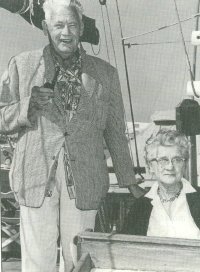
|
By 1963, however, with Hugh at seventy-seven years of age,
and life aboard Sea Rover probably becoming a little difficult for them, they again moved ashore.
This time they joined
their daughter, Ida, at her home in Naples, California. The Angelmans sold the Sea Rover,
but Hugh built another "ship room" at Ida's home complete with bunks, chart
drawers, and a mast between floor and ceiling so they could truly feel at
home.
Hugh died in 1967 at the age of 81 after a
long and fruitful career, and a legend in his own time. Shortly
before he passed away, the grand old man of Pacific yachting told his
daughter Ida, "I still have lots of boats inside my head."
Hugh Angelman's legacy
lives on as many of the boats he designed continue to sail the seven
seas. Angelman yachts remain the prized
possessions of many proud owners prized for their comfort, continuing durability, and
their timeless enduring beauty. To own "an Angelman" yacht is to be in a class
apart.
W. R. Carr
Nov., 2006
Source References
"The Grand Old Man of Pacific Yachting, the Enduring West Coast
Legacy of Hugh Angelman" by Robby Coleman with Thomas G. Skahill,
and "Pure Sea Witch" by Robby Coleman
WoodenBoat, No. 147, Mar/Apr 1999
"South Coast Company The life of a full-service yacht
yard," by Thomas G. Skahill. (WoodenBoat, No. 193, Nov/Dec
2006)
The "Residential History of Portuguese Bend, Rancho Palos Verdes,
Los Angeles," by Connie Luffkin. (http://www.geocities.com/pbchost/History/history.htm)
A short biographical sketch posted on the Naples (Florida) Sailing & Yacht
Club website: http://ouryachtclub.memfirstweb.net/Club/Scripts/Home/home.asp
Photo credits: (1) Angelman on Sea Witch, contributed by
Stephen Carlson. (2) Angelman standing between Sea Rover and Sea Witch,
courtesy of Thomas G. Skahill. (3) Angelman with unidentified friend on
Sea Rover, contributed by Stephen Carlson. (4) Angelman as a young
sailor, courtesy of Thomas G. Skahill. (5) Hugh and Leslie on the Sea
Rover, courtesy of George Hylkema. Photos 2, 4 and 5 appeared with Robby
Coleman and Thomas G. Skahill's article in
WoodenBoat, No. 147, Mar/Apr 1999.
|
